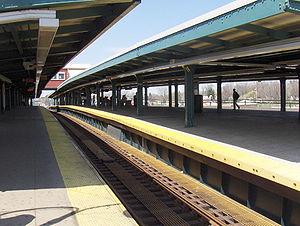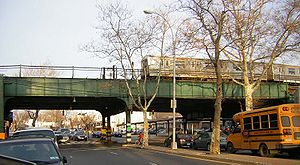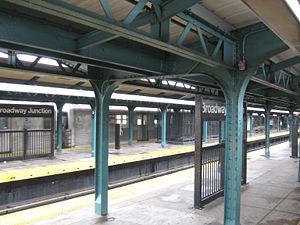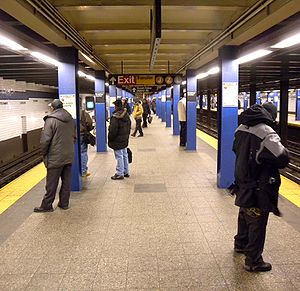- Broadway Junction (New York City Subway)
-
For the Brooklyn neighborhood, see Broadway Junction (Brooklyn).
Broadway Junction





New York City Subway rapid transit station complex
Jamaica-bound crosses Eastern Parkway while entering Broadway Junction station
crosses Eastern Parkway while entering Broadway Junction stationStation statistics Address Van Sinderen Avenue & Fulton Street
Brooklyn, NY 11233Borough Brooklyn Locale Bedford-Stuyvesant (Broadway Junction)/East New York Coordinates 40°40′44.11″N 73°54′12.43″W / 40.6789194°N 73.9034528°WCoordinates: 40°40′44.11″N 73°54′12.43″W / 40.6789194°N 73.9034528°W Division B (BMT/IND) Line BMT Canarsie Line
BMT Jamaica Line
IND Fulton Street LineServices A  (all times)
(all times)
C (all except late nights)
(all except late nights)
J (all times)
(all times)
L (all times)
(all times)
Z (rush hours, peak direction)
(rush hours, peak direction)Connection - New York City Bus: B12, B20, B25, B83, Q24, Q56
- LIRR Atlantic Branch at East New York
Levels 3 Other information Traffic Passengers (2010) 2,767,838[1]  2.8%
2.8%Rank 169 out of 422 Station service legend Symbol Description 
Stops in station at all times 
Stops all times except late nights 
Stops late nights only 
Stops late nights and weekends only 
Stops weekdays only 
Stops all times except rush hours in the peak direction 
Stops all times except weekdays 
Stops rush hours only 
Stops rush hours in the peak direction only 
Station is closed (Details about time periods) Broadway Junction is a New York City Subway station complex shared by the elevated BMT Canarsie Line and BMT Jamaica Line, and the underground IND Fulton Street Line. It was also served by trains of the Fulton Street Elevated until that line closed in 1956. It is located roughly at the intersection of Broadway, Fulton Street, and Van Sinderen Avenue at the border of Bedford-Stuyvesant and East New York, Brooklyn. The fare control area is located at the eastern end of the Fulton Street Line station. The complex is served by the:
- A, J, and L trains at all times
- C trains at all times except late nights
- Z trains during rush hours in the peak direction only
Contents
History
The name Manhattan Junction or Manhattan Beach Junction was applied to the station on what is now the Jamaica Line when it opened in 1885;[2][3] the area had been known as Manhattan Beach Crossing since before then,[4][5] due to the crossing of the Long Island Rail Road's Manhattan Beach Division. A station on the Fulton Street Elevated at Sackman Street opened on July 4, 1889,[6][citation needed] when the line was extended to Atlantic Avenue.
A two-track one-half-block elevated connection was built along on the east side of Vesta Avenue (now Van Sinderen Avenue) between the Fulton Street and Broadway Lines.[7] This connection, equipped with third rail, was opened on August 9, 1900, and new service patterns were implemented: during times other than rush hours, Lexington Avenue and Fulton Street trains were through-routed, and travel beyond Manhattan Junction required a transfer.[8][9] This "East New York Loop" was unpopular, and was soon stopped; the next service to use the tracks was the BMT Canarsie Line to Broadway Ferry (later the 15 train), joined to the Fulton Street Line at Pitkin and Snediker Avenues in 1906.[citation needed]
The name was changed from Manhattan Junction to Broadway Junction in 1913.[10]
The next west stop for the Fulton Street Line was Rockaway Avenue. The next stop east was Atlantic Avenue.
BMT Jamaica Line platforms
Broadway Junction


New York City Subway rapid transit station
Southbound train departing
train departingStation statistics Division B (BMT) Line BMT Jamaica Line Services J  (all times)
(all times)
Z (rush hours, peak direction)
(rush hours, peak direction)Structure Elevated Platforms 2 island platforms
cross-platform interchangeTracks 3 Other information Opened June 14, 1885[5] Former/other names Broadway – Eastern Parkway Station succession Next north Alabama Avenue: J 
(Z skips to Van Siclen Avenue)
skips to Van Siclen Avenue)
Atlantic Avenue (Canarsie): no regular service
(Terminal): J Z
Z 
Next south Chauncey Street (local): J  Z
Z 
(J skips to Halsey Street)
skips to Halsey Street)
Myrtle Avenue (express): no regular serviceStation service legend Symbol Description 
Stops in station at all times 
Stops all times except late nights 
Stops late nights only 
Stops late nights and weekends only 
Stops weekdays only 
Stops all times except rush hours in the peak direction 
Stops all times except weekdays 
Stops rush hours only 
Stops rush hours in the peak direction only 
Station is closed (Details about time periods) Broadway Junction is an express station on the BMT Jamaica Line that has three tracks and two island platforms. The middle express track is not used in regular revenue service. At each end of the station there are also track connections to the East New York Yard. Trains that run to/from that yard can terminate or begin at this station.
The station was originally called Broadway – Eastern Parkway, named for its original exit on the extreme west end of the platforms. This entrance is now closed. The ironwork for the old Fulton El trackways which can be seen under this portion of the complex from the platforms. The mezzanine is above the platforms and connects to the Canarsie Line and to the exit at street level via two long escalators. At street level, there is a transfer to the underground IND Fulton Street Line and the fare control area. The upper mezzanine extends most of the length of the platforms and is made of concrete. Windows were once present, but are now cemented over.
BMT Canarsie Line platforms
Broadway Junction

New York City Subway rapid transit station 
Southbound side platform for the train;
train;
with northbound island platformStation statistics Division B (BMT) Line BMT Canarsie Line Services L  (all times)
(all times)Structure Elevated Platforms 1 island platform
1 side platform (southbound only)Tracks 2 Other information Opened December 14, 1928 Station succession Next north Bushwick Avenue – Aberdeen Street: L 
Next south Atlantic Avenue: L 
Station service legend Symbol Description 
Stops in station at all times 
Stops all times except late nights 
Stops late nights only 
Stops late nights and weekends only 
Stops weekdays only 
Stops all times except rush hours in the peak direction 
Stops all times except weekdays 
Stops rush hours only 
Stops rush hours in the peak direction only 
Station is closed (Details about time periods) Broadway Junction on the BMT Canarsie Line has two tracks, one island platform, and one side platform. Manhattan-bound trains use the island platform for northbound service while Canarsie-bound trains use the side platform for southbound service. However, the latter can use the island platform if necessary.
This station is one of the highest elevated platforms in the city, sitting above the already-elevated BMT Jamaica Line. As high as this station platform is, it plunges abruptly into a tunnel at the north end. This end of the station slopes sharply downward, and the platform end is about 200 yards (180 m) away from the tunnel's portal. A new diamond crossover has been installed here. A fine view of the East New York Yard can be seen from the northbound platform. The south end of the northbound platform divides into two "legs." Two normally-unused tracks connect the Canarsie and Jamaica lines. Now and then, a train being rerouted will use these tracks. The southbound track can be seen emerging beneath the two "legs" of the northbound platform; the northbound "flyover" with its severe curve can be seen just east of the station, beginning near the signal tower. Since 1999, this station has been undergoing a series of renovations, including new canopies, a new crossover (known as 'The Barn' because of its rustic red siding and white trim), and the removal of a hazardous crossunder. The old-style platform lights were removed and replaced with "loop" fixtures, widely seen elsewhere in the system.
From the northbound platform looking east, the control tower of John F. Kennedy International Airport in Queens can be seen over five miles (8 km) away. It is also possible to see planes landing and taking off from the airport.
The 2001 artwork is called Brooklyn, New Morning by Al Loving.
IND Fulton Street Line platforms
Broadway Junction


New York City Subway rapid transit station
Northbound train arriving on the local track
train arriving on the local trackStation statistics Division B (IND) Line IND Fulton Street Line Services A  (all times)
(all times)
C (all except late nights)
(all except late nights)Structure Underground Platforms 2 island platforms
cross-platform interchangeTracks 4 Other information Opened December 30, 1946 Former/other names Broadway – East New York Station succession Next north Rockaway Avenue (local): A  C
C 
Utica Avenue (express): A
Next south Liberty Avenue (local): A  C
C 
Euclid Avenue (express): A
Station service legend Symbol Description 
Stops in station at all times 
Stops all times except late nights 
Stops late nights only 
Stops late nights and weekends only 
Stops weekdays only 
Stops all times except rush hours in the peak direction 
Stops all times except weekdays 
Stops rush hours only 
Stops rush hours in the peak direction only 
Station is closed (Details about time periods) Broadway Junction is an express station on the IND Fulton Street Line, formerly called Broadway – East New York. It has four tracks and two island platforms. The fare control is at the east (railroad south) end of the station; this entrance also serves the J, L and Z trains via newly-replaced escalators from street to elevated level. There is also a police precinct located in the mezzanine. If there was a former western end exit, there is no longer any evidence of it.
This station remained an unfinished shell during World War II due to material shortages. Its tile band is unique in that it incorporates two types of tile – gloss and matte – in contrasting shades of cobalt blue (gloss border) and blueberry (matte center). When the station was renamed in 2007, the "EAST NY" tiles on the wall were removed and replaced by tiles reading "JUNCTION", in the matching IND copperplate font.
There is an active tower just past the head end of the Queens-bound platform.
East of the station are bellmouths. These bellmouths was built for a proposed extension along the BMT Jamaica Line, or for proposed Jamaica Avenue Subway.[11] It was not a provision for the IND Second System as were similar structures on other IND lines. One of these bellmouths has an emergency exit. There is nothing on the model board in the Broadway/East New York tower to show this provision.
References
- ^ "Facts and Figures: 2010 Annual Subway Ridership". New York City Metropolitan Transportation Authority. http://mta.info/nyct/facts/ridership/ridership_sub_annual.htm. Retrieved 2011-05-18.
- ^ "Building a Terminus". Brooklyn Daily Eagle: p. 1. September 18, 1885. http://eagle.brooklynpubliclibrary.org/Default/Scripting/ArchiveView.asp?BaseHref=BEG/1885/09/18&Page=1&skin=BE.
- ^ "The Brooklyn Elevated". Brooklyn Daily Eagle: p. 1. January 3, 1886. http://eagle.brooklynpubliclibrary.org/Default/Scripting/ArchiveView.asp?BaseHref=BEG/1886/01/03&Page=1&skin=BE.
- ^ "Going Ahead". Brooklyn Daily Eagle: p. 4. April 3, 1880. http://eagle.brooklynpubliclibrary.org/Default/Scripting/ArchiveView.asp?BaseHref=BEG/1880/04/03&Page=4&skin=BE.
- ^ a b "East New York". Brooklyn Daily Eagle: p. 6. June 13, 1885. http://eagle.brooklynpubliclibrary.org/Default/Scripting/ArchiveView.asp?BaseHref=BEG/1885/06/13&Page=6&skin=BE.
- ^ "The Fulton Street Elevated". Brooklyn Daily Eagle: p. 6. June 28, 1889. http://eagle.brooklynpubliclibrary.org/Default/Scripting/ArchiveView.asp?BaseHref=BEG/1889/06/28&Page=6&skin=BE.
- ^ "To Join Elevated Roads". Brooklyn Daily Eagle: p. 3. September 8, 1899. http://eagle.brooklynpubliclibrary.org/Default/Scripting/ArchiveView.asp?BaseHref=BEG/1899/09/08&Page=3&skin=BE.
- ^ "Loop in Operation". Brooklyn Daily Eagle: p. 3. August 9, 1900. http://eagle.brooklynpubliclibrary.org/Default/Scripting/ArchiveView.asp?BaseHref=BEG/1900/08/09&Page=3&skin=BE.
- ^ "Twenty-Sixth Warders Complain of New L Loop". Brooklyn Daily Eagle: p. 3. August 10, 1900. http://eagle.brooklynpubliclibrary.org/Default/Scripting/ArchiveView.asp?BaseHref=BEG/1900/08/10&Page=3&skin=BE.
- ^ Brian J. Cudahy, Under the Sidewalks of New York: The Story of the Greatest Subway System in the World, page 60
- ^ http://www.youtube.com/watch?v=9FiS6X83UvM The bellmouth can be seen towards the right, at the 5:40 mark in the video, just before the train enters the Broadway Junction station.
External links
- nycsubway.org — BMT Canarsie Line: Broadway Junction
- nycsubway.org — BMT Jamaica Line: Broadway Junction
- nycsubway.org — IND Fulton: Broadway/East New York
- nycsubway.org — Brooklyn, New Morning Artwork by Al Loving (2001)
- Station Reporter — Broadway Junction Complex
- The Subway Nut — Broadway Junction – East New York (A,C) Pictures
- The Subway Nut — Broadway Junction – Eastern Parkway (J,L,Z) Pictures
- MTA's Arts For Transit — Broadway Junction
- Van Sinderen Avenue entrance which is the sole entrance to Broadway Junction from Google Maps Street View
Categories:- BMT Canarsie Line stations
- BMT Jamaica Line stations
- IND Fulton Street Line stations
- BMT Fulton Street Line stations
- New York City Subway transfer stations
- New York City Subway stations in Brooklyn
Wikimedia Foundation. 2010.




